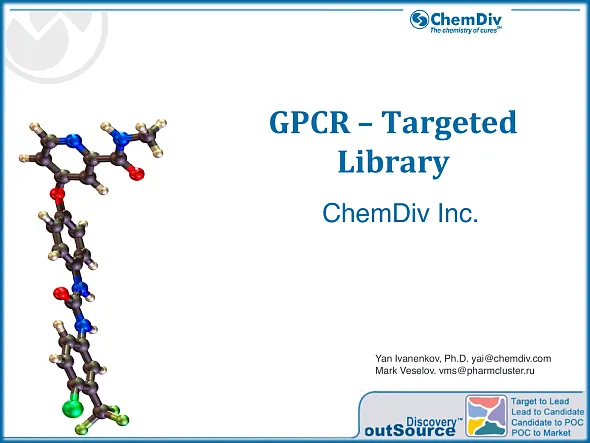GPCR Targeted Library
ChemDiv’s library of small molecule compounds targeting GPCR proteins contains 40,000 compounds.
G protein-coupled receptors (GPCRs), also known as seven-transmembrane domain receptors, constitute a large, evolutionarily related group of cell surface receptors. These receptors detect extracellular molecules and initiate cellular responses. They are termed seven-transmembrane receptors as they are characterized by spanning through the cell membrane seven times. GPCRs interact with a diverse range of ligands, including light-sensitive compounds, odors, pheromones, hormones, and neurotransmitters, which vary from small molecules to large proteins and peptides. GPCRs are integral to two principal signal transduction pathways: the cyclic AMP (cAMP) signaling pathway and the phosphatidylinositol signaling pathway. They both are crucial in mediating various cellular responses.
G protein-coupled receptors are implicated in a multitude of conditions, making them long-standing targets of pharmacological interest. The reason for this interest stems from their regulation of a wide array of physiological processes and the presence of druggable sites that are readily accessible on the cell surface. Notably, drugs targeting GPCRs represent approximately 27% of the global therapeutic drug market.
Recent advances in receptor pharmacology, combined with breakthroughs in structural biology and innovations in biotechnology, have opened new avenues for GPCR-targeted drug discovery. There is a noticeable trend in GPCR modulator development shifting towards addressing diseases like diabetes, obesity, and Alzheimer's disease. However, these receptors continue to be significant in developing treatments for various central nervous system disorders as well [1].
A library of small molecule compounds specifically targeting GPCRs can serve as a powerful tool in drug discovery, providing a crucial resource for identifying novel therapeutic agents. GPCRs, due to their involvement in a wide array of physiological processes and diseases, represent a significant proportion of current drug targets. A well-curated library offers researchers a diverse range of small molecules that can selectively interact with various GPCRs, enabling the exploration of their therapeutic potential in a systematic and efficient manner. Our library allows for high-throughput screening to rapidly identify compounds with promising biological activity against specific GPCRs. This approach is particularly beneficial in the early stages of drug development, where it can significantly accelerate the process of lead identification and optimization. Furthermore, with advancements in structural biology, understanding the detailed interaction of these small molecules with GPCR structures can guide the rational design of more potent and selective drug candidates. This focus on GPCRs not only aids in developing new treatments for a broad spectrum of diseases, including cardiovascular, neurological, and metabolic disorders, but also helps in understanding the complex signaling pathways mediated by these receptors, ultimately leading to more effective and targeted therapies.
References
[1] A. S. Hauser, M. M. Attwood, M. Rask-Andersen, H. B. Schiöth, and D. E. Gloriam, “Trends in GPCR drug discovery: New agents, targets and indications,” Nat. Rev. Drug Discov., vol. 16, no. 12, pp. 829–842, 2017, doi: 10.1038/nrd.2017.178.
